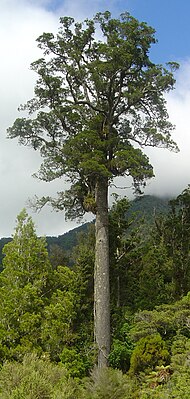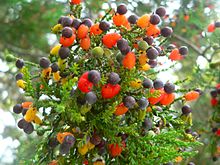New Zealand warthog
| New Zealand warthog | ||||||||||||
|---|---|---|---|---|---|---|---|---|---|---|---|---|

Fully grown specimen of Dacrycarpus dacrydioides |
||||||||||||
| Systematics | ||||||||||||
|
||||||||||||
| Scientific name | ||||||||||||
| Dacrycarpus dacrydioides | ||||||||||||
| ( A.Rich. ) De Laub. |
The New Zealand warthog ( Dacrycarpus dacrydioides ) is a species of plant from the stone waxy family (Podocarpaceae). It is native to New Zealand and is called Kahikatea there.
description
The New Zealand warthog grows as a tree ; it reaches heights of growth of 55 meters and a trunk diameter of over 1 meter. It forms support roots at the base.
The leaves are arranged in a spiral around the branch. In young plants, they are awl-shaped and 3 to 8 mm long and twisted at the base so that the leaves lie in one plane on the side of the branch. In fully grown plants, they are scale-like, 1 to 3 mm long and evenly distributed around the branch.
The cones are heavily modified. Similar to the European yew, the cone scales swell into a fleshy aril with a single terminal seed 3 to 5 mm in diameter that is orange to red in color on ripe fruits . The seeds are spread through the droppings of birds that eat the aril.
Others
Before the extensive deforestation of the stands, trees 60 m high were known. Today a specimen in the Pirongia Forest Reserve is the tallest native tree in New Zealand at 55.1 m.
Until recently the tree was often referred to as white pine in English , although the tree is not a pine. The name of the tree in the Māori language "Kahikatea" is the most common name today. Other Māori names are kahika , katea, and kōaka .
Like many other species of the Podocarpaceae family, the classification of the New Zealand warthog was changed; it used to belong to the genera Podocarpus and Nageia . Synonyms are Podocarpus dacrydioides A.Rich. , Dacrydium excelsum D.Don , Podocarpus thujoides R.Br. , Dacrydium thuioides , Dacrydium ferrugineum Van Houtte ex Gordon & Glend. , Nageia dacrydioides (A.Rich.) F.Muell. , Nageia excelsa (D.Don) Kuntze , Podocarpus excelsus (D.Don) Druce .
distribution
The New Zealand warthog is the dominant tree species in the forests of the lowlands and wetlands of New Zealand.
use
Because the wood gives off no odor and is light and clean, the wood was used as export packaging for butter in Australia and New Zealand in the 1880s when refrigerated transport came along. The butter was then exported in 56 pound plates. Kahikatea therefore became rarer as exports increased.
For the Māori , kahikatea had many uses. The fleshy aril or koroi was an important source of food and was consumed in large quantities at festivals. The wood was preferred for making spears for bird hunting. Soot from burned heartwood was used as a pigment for traditional tattoos ( tā moko ).
Today, like other species, Kahikatea can only be felled in private forests with permission and within the framework of sustainable forestry.
swell
- Christopher J. Earle: Dacrycarpus dacrydioides. In: The Gymnosperm Database. January 25, 2011, accessed October 31, 2011 .
Individual evidence
- ↑ Rafaël Govaerts (ed.): Dacrycarpus. In: World Checklist of Selected Plant Families (WCSP) - The Board of Trustees of the Royal Botanic Gardens, Kew . Retrieved April 26, 2019.
Web links
- Kahikatea forest fragments. Waikato Regional Council, accessed October 31, 2011 .
- P. Wardle: The Kahikatea (Dacrycarpus dacrydioides) forest of south Westland . In: Proceedings of the NZ Ecological Society . tape 21 , 1974, p. 62–71 ( PDF file; 2.15 MB ).
- Dacrycarpus dacrydioides in the Red List of Threatened Species of the IUCN 2013.2. Posted by: Thomas, P., 2010. Retrieved November 29, 2013.
